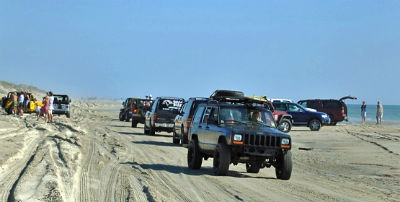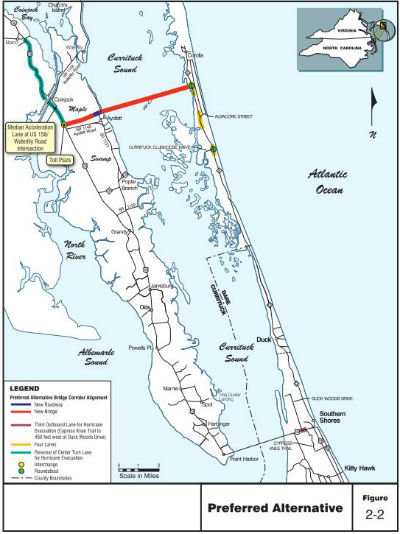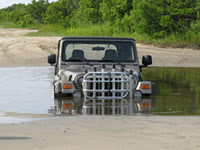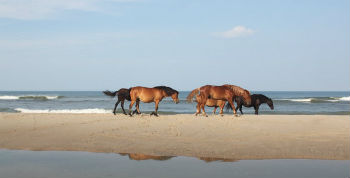 Traffic can get heavy in the summer along the 11-mile section of beach leading to Carova. Some wonder what it would be like if a new bridge is built over Currituck Sound. |
CAROVA — At 6 a.m. on a July day last year, volunteers posted themselves near the entrance to the unpaved area on the northern tip of the Currituck County Outer Banks and started counting.
There were vehicles with North Carolina tags. Vehicles with Virginia tags. Open “cattle trucks” with groups of tourists. Rented Jeeps. Guided tour vehicles.
Supporter Spotlight
All day and into the night, they kept coming. By 8:30 p.m., the numbers were impressive: A total of 1,136 vehicles —207 of them related to tours — holding 3,663 people. All driving along 11 miles of sand road in Carova.
“Can you imagine the impact that the Mid-Currituck Bridge would have on these numbers?” Lynne Wilson, a Carova resident, said in an e-mail. “The safety of beachgoers is threatened now and will be disproportionately threatened if bridge traffic turns north, which of course, it will.”
As the state approaches the final step in the planning process to build the seven-mile toll bridge from mainland Currituck County to Corolla, many residents of Corolla and the unincorporated off-road community, where 136 wild horses famously roam, are cringing at the prospect that it may actually happen.
“It’s going to bring significantly more people,” said John Grattan, a semi-retired environmental attorney who lives in Corolla.
And when the weather makes beach-going impossible, he said, all those vacationers, en masse, will head south. “Once they’re here, the first rainy Thursday is going to be the biggest nightmare you ever saw.”
Supporter Spotlight
 The preferred route has the bridge anchored off U.S. 158 north of Aydlett and landing between the Corolla Bay and Monteray Shores subdivisions, at least 300 feet from houses and lots on N.C. 12. Source: N.C. Department of Transportation. |
At the same time, the $660 million project, which was first proposed about 20 years ago, is strongly favored by Currituck and Dare counties and the towns of Kitty Hawk, Southern Shores and Duck, which have suffered through hours-long traffic backups on U.S. 158 and N.C. 12 every summer for years. At the height of the season, it can take four hours on a Saturday to reach Corolla from Moyock, normally 1.5-hour trip.
The bridge would shave about an hour off the drive from Virginia and decrease the volume of heavy traffic. Proponents also say the bridge would make hurricane evacuation time faster, increase employment opportunities on both sides of the bridge and decrease commuting time for seasonal workers.
“There is a congestion problem, I agree, on certain weekends,” Grattan said. “But the proposed bridge solution is a ridiculously expensive and environmentally damaging option (that’s) solving the congestion problem at the expense of Corolla.”
In the project’s final environmental impact statement released in January, the preferred alternative has the bridge anchored off U.S. 158 north of Aydlett and landing between the Corolla Bay and Monteray Shores subdivisions, at least 300 feet from houses and lots on N.C. 12.
In just a short drive to the north, the asphalt ends and the land of wild horses and beach driving begins.
Wilson said that tourism promotion of the off-road beaches, featuring photographs of the wild horses on the edge of the surf, has been wildly successful. “The results are evident,” she said. “Tourists are flocking to Currituck’s off-road beaches. And the outcome might very well be self-defeating: overcrowding and unsafe beaches are not a destination of choice.”
As the numbers of day-trippers have increased, so has development. But many of the 180 or so year-round residents in Carova are concerned that infrastructure is already being strained, and it’s only 20 percent built-out. There are no restaurants, bathrooms or gas stations. The only public parking is on the beach, where trucks bounce along just a few feet from sunbathers. Sometimes, wild horses join the fray, strolling down to the water to cool off.
“Each year, more and more traffic comes up here,” said Jerry Gillet, the secretary of the Carova Beach Volunteer Fire Department. “Sometimes the beach is very, very difficult to negotiate because of the traffic and the horse tours. Sometimes we have a hard time negotiating our emergency vehicles.”
 Driving to Carova is tricky. Driving to Carova is tricky. |
Driving in sand is tricky, and often day visitors are inexperienced. Consequently, they don’t let the air out of their tires, causing their vehicles to get stuck or their tires to spin, leaving behind ruts.
“When you multiply that by hundreds of vehicles over 11 miles, it creates a washboard effect,” said J.P. Peron, owner of The Outer Banks Real Estate Co. in Carova.
Peron, a member of the volunteer fire department, said that the department analyzed their calls between 2000 and 2010 and found that five times more calls were responding to vehicle fires — caused by people overheating their transmissions while trying to get unstuck — than house fires.
Until about 2005, Carova was truly remote and isolated. Gillet said that for years after moving to the community in 1998, his North Swan Beach house was the only one within a quarter-mile in either direction.
“When the building boom happened,” he said, “I’m guessing in the general vicinity, there must have been 30 houses put up.”
Originally, in the late 1970s, the area was platted for commercial use, with developers counting on a highway being built from Sandbridge, Va, said Ben Woody, Currituck County planning director. But in subsequent years, part of the land was acquired for False Cape State Park. Then the federal government designated the entire off-road area as a COBRA zone, precluding the purchase of federal flood insurance and restricting certain infrastructure.
“When they platted it, I don’t think they intended there would be no roads there,” Woody said.
Currituck County later zoned Carova — the name blends Carolina and Virginia — as single-family residential with a minimum lot size of three acres.
 The wild horses of the northern Outer Banks compete with SUVs on the beach. |
The developer of a proposed 37-acre commercial development in Swan Beach, the northern-most subdivision, sued Currituck County in early July over the county’s rejection of a request for a conditional zoning change from residential to commercial. The proposal includes plans for an inn with 32 suites, a fishing pier, retail shops and restaurants.
Woody said that, as of 2011, a total of 3,150 lots were platted in the 12,000-acre off-road area. Of them, 665 have been permitted, and 2,526 are vacant lots. And many of those were grandfathered when the current three-acre zoning was implemented.
“We have thousands of one-third- and half-acre lots that can be built upon,” he said.
There are no restrictions on the number of bedrooms in a house, he said, as long as the parcel is big enough to provide septic. So far, the largest house in Carova is 23 bedrooms, and there are numerous houses with 10 to 18 bedrooms.
Yet, with no central water or wastewater system in Carova — it’s all wells and septic tanks — and a high water table, Woody said, there are legitimate concerns about how much capacity remains for growth.
A Beach Driving committee last year recommended that the county hire a consultant to conduct a study on establishing a permit system for off-road vehicles. It also recommended that numerous improvements be provided, including educational signs, a bathhouse, air stations and better ramp maintenance. Some recommendations have been implemented, but the permit system is not one of them.
Currituck County recognizes the value of an infrastructure study in Carova to determine what must be addressed as the community continues to accommodate more visitors and more development, Woody said. But so far, he agreed that issues have mostly been dealt with in a piecemeal, as- needed, basis.
“We haven’t stepped back,” he said, “and really looked at that area comprehensively to project into the future the need for planning.”
If the Mid-Currituck Bridge is built, whether more people come or not, Carova will become more accessible.
But the bridge is not necessarily a done deal. In addition to stiff opposition from a substantial number of northern beach residents, the bridge is vulnerable to cuts in the state budget and to lawsuits. Although the project would be partially funded by user tolls, it is also dependent on millions of tax dollars toward payments on revenue bonds.
So-called “gap funding” appropriations for the bridge and another toll project in Gaston County were cut from this year’s budget because they were not expected to be needed until June 30, 2013, said Greer Beaty, a state Department of Transportation spokeswoman.
The Currituck project’s record of decision, the last step required before construction can begin, is expected any time now, Beaty said. After that issued, those objecting to the project have 180 days to file a lawsuit.
Barring legal action, Beaty said that DOT has “other resources that we can and will use” to move the project forward if the $28 million in gap funding is not restored.
Bridge opponent Jen Symonds, an Aydlett resident and a founder of No Mid-Currituck Bridge, however, said she believes the Currituck bridge may be doomed by a combined loss of political support and lack of money. It’s difficult to defend, she said, spending $660 million — and charging a $28 toll each way — to save tourists an hour of driving about 26 days a year.
“My understanding is that the GOP leadership does not think this is a viable project,” Symonds said. “I don’t think it’s going to get the funding. I think the days of mega-projects for powerful politicians are gone. The state can’t afford it.”







